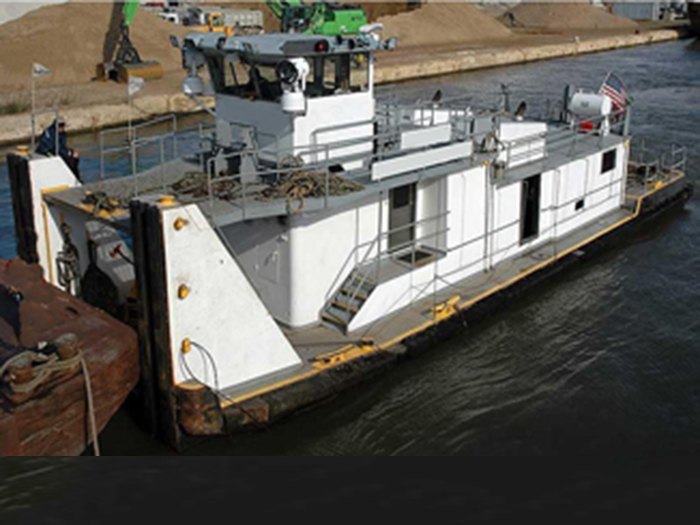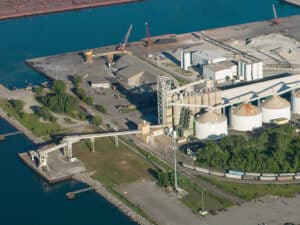
Marcon releases new push boat market report
Written by Nick Blenkey
Vessels currently listed by Marcon include this 1971-built inland river push boat with a retractable wheelhouse.
The latest newsletter from Coupeville, Wash.-headquartered shipbroker Marcon International Inc. includes an an analysis of the inland river push boat market, based on a longer full market report available from the company.
As of the end of May 2020, the brokerage reports that it was tracking 779 inland river pushboats with 73 officially on the market for sale (57 U.S. flag and 16 foreign flag). Seven of the boats with age listed were built within the last 10 years, while 38 boats are 45 years of age or older. The oldest listed was built in 1944, a 76 ft, 1,110 BHP vessel in the U.S. Northwest. This is counterbalanced by a 2019-built 56 ft, 1,500 BHP U.S. flag inland river push boat located in the U.S. Southeast.
Marcon also has 10 inland river pushboats listed for charter—six U.S. and four foreign.
The number of inland river push boats officially on the market for sale in total is 73, down 25, or 25.77%, from the firm’s last report published in August 2019. This is 22 units, or 23.16%, less than one year ago in May 2019 . Composition of horsepower range in the last year has changed with the biggest shifts being seven fewer under 1,000 HP boats with an average build year of 1980 (compared to 1970 one year ago), five fewer 2,000-3,000 HP (average build year now 1977 vs. 1973 one year ago) and three fewer 1,000-2,000 HP (1975 vs. 1972) push boats offered through Marcon.
Today, Marcon does not have any push boats offered greater than 5,000 HP, which reflects the position of the inland market, which, says the brokerage, “has been running pretty good despite current events, seasonal flooding of record proportions, and the overall commercial marine market slowdown.” This was mostly reflected in demand within the tank barge market, versus the bulk cargo market which has had a very difficult time. As brokers, Marcon understands that a 4,200 BHP U.S. flagged unit in the 140’ LOA range, and built in1970s, sold recently at a very good price in the $2 million range.
Only 9.59% of the push boats that Marcon has available for sale are less than 10 years old, up from the 7.37% reported one year ago. In looking at overall fleet age and then by U.S. flagged versus foreign flagged, over the past five years Marco sees a decrease in overall age and of U.S.-flagged push boats on the market, while average age of foreign-flagged push boats increased.
Five years ago, the average age of all on push boats on the market through Marcon was 43 years, compared to 46 years one year ago and 43 years as of this report. That is driven mostly by older U.S.-flagged vessels going on the market, aging from 46 years in 2015 to 49 years in 2019 then down to 44 years now.
Foreign flagged push boats went from 34 years old last year and five years ago and then up to 40 years as of this report.
During the first quarter of 2020, Marcon saw an expected drop in freight activity in the inland river systems of the U.S. due to the effects of the COVID-19 shutdowns, decreasing consumer demand domestically and decreased manufacturing output. All of these had a major impact on the entire dry market segment.
Following the record setting flooding during 2019, Marcon says the 2020 season has started out similarly causing fears of a repeat of last year’s difficulties in the inland dry cargo market.
HIGH WATER LEVELS
“High water levels and spring flooding will always have an impact on the market, which also delays plantings, causing reduced demand for fertilizer heading north in the early part of the year,” says Marcon. It adds that delays to infrastructure projects have also helped to trigger overcapacity, which can be an impetus for consolidation and buyouts. All of this continued downward trending activity will only lead to more idling of equipment and a corresponding fallout of demand.
It is generally considered at this time that the dry cargo market is about 20% oversupplied with barges, says Marcon, and an expected weakened demand can continue to be foreseen related to trade disputes and other factors moving forward during 2020.
China’s total imports of soy beans have dropped upwards of 12% (April 2020 report), and this was attributed to bad weather and delaying of cargoes (which are now majority supplied by Brazil). However, this all comes on the heels of a total collapse in the market in 2018 due mainly to a trade war with China.
“This literally killed overall demand in the Far East exports, and leveled a 75% drop in demand from that reliable buyer of the product during that year,” says Marcon. “The drop in overall coal demand, agriculture related planting delays and the drop in demand for cargoes like sand (fracking industry shut down due to collapse of oil prices in the quarter), are contributing to the collapse in demand for tonnage creating an ‘over tonnage’ situation for the inland market. Overall export levels to the Far East market remain stagnant, and a continued re-brewing of a new trade war with China (attributed to fallout over the COVID-19 response, as well as actions taken by China in Hong Kong), will likely continue to hamper exports in the bulk grain markets for an unknown, but extended, period of time.”
Download Marcon’s full push boat market report HERE

![Tom Frazier aground and listing to starboard on Feb. 11, 2024. [Photo: U.S. Coast Guard]](https://www.marinelog.com/wp-content/uploads/2025/06/Towboataground-300x225.jpg)


